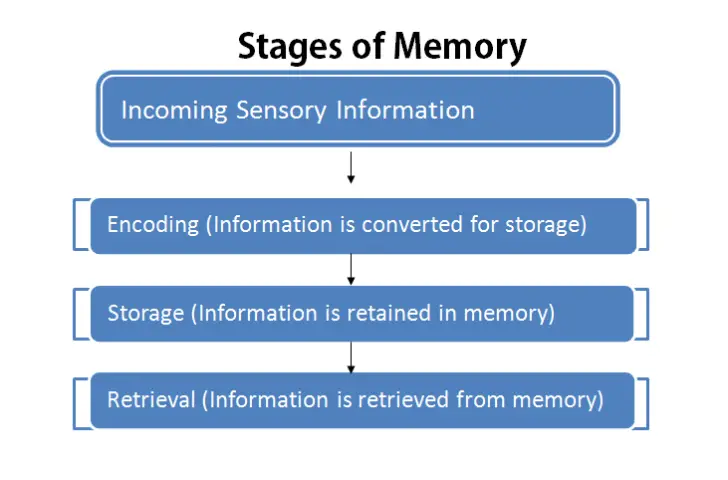Memory is the process of maintaining information over time. – Matlin, 2005
The general understanding of memory is storing certain information, which of course, isn’t a complete definition of the memory as a whole.
Sternberg defined memory as the means to draw past experiences in order to assess the information at the present. The complete process of structuring and processing the information involved in the storage and retrieval of such information can be defined as memory.
Memory processes limitless amount of information every day, and information is stored in different forms like meaning, sounds and images. From storing the information to the final processing in order to produce a desired outcome, memory can be categorized into three stages.

Encoding
Encoding is the first stage of memory. As the term suggests, this is the stage of memory which accumulates all the information from the surrounding and encodes or stores it in our brain. The information we intake from the world around us is processed in three different forms.
- Visual (picture)
- Acoustic (sound)
- Semantic (meaning)
In simple words, these different forms are how we take in the information. We either consume information as a picture, a sound, or we make it meaningful. These three different forms are termed as visual, acoustic and semantic accordingly. Encoding can also be defined as the process used to remember the information. We retrieve information in the same form we take it in because of this process.
For instance, consider remembering a certain telephone number. You are seeing it, means it’s visual coding. If you’re repeating the number to yourself verbally in order to remember it, that’s acoustic coding. Likewise, if you perceive that the last three numbers of the phone number are same, all 3s, you are giving meaning to it. All three forms of encoding takes place so that you can remember that particular number.
It has been found out that acoustic coding is the major form of encoding in Short Term Memory. Likewise, the major encoding system for the Long Term Memory seems to be semantic, with meaning. But it’s not just limited to that, and can be done in visual and acoustic forms too.
Storage
This stage deals with nature of the memory where the information is stored, time duration of the memory, the amount of information that can be stored, and type of memory. The manner in which information is stored directly affects the way in which information is retrieved. Information is stored in two main parts of memory.
- Short Term Memory (STM)
- Long Term Memory (LTM)
Miller stated in 1956 that most adults are capable of storing within 5 to 9 items in their STM, short term memory, and he called it the magic number 7 (plus or minus 2). According to findings of Miller, there is limited number of slots in Short Term Memory; however, he didn’t specify the amount of information that can be stored in each memory slots. This gives the idea that more than one information can be stored together if information can be related and chunked, one upon another.
Total capacity of Short Term memory is said to be around 0 – 30 seconds.
Long Term Memory, however, is a whole different ball game when it comes to memory. Its capacity is said to be unlimited and the information stored can last a whole life time.
For example, we might remember the color of someone’s dress only for a while if it’s stored in short term memory. However, we remember that the sun rises from the east, and we will probably remember it for the rest of our lives, which is the information stored in long term memory.
Retrieval
As the term suggests, retrieval refers to retrieving information out of our memory storage. Failure to retrieve information is often understood as not being able to remember or recall the particular information. Trying to retrieve information from our memory makes the differences between STM and LTM pretty apparent.
STM is both stored and retrieved in a sequential manner. For example, let’s say a subject is given a phone number to remember and then asked the second last number on the list. The person goes through the number from the start to retrieve the required information.
LTM is both stored and retrieved by association. Remembering a certain action might lead to retrieval of information about some other actions. For instance, traveling the same road you were walking the day before might lead you to retrieve information about the girl you had seen the day before.
Memory organization is one of the ways to increase your ability to retrieve memory. Information can be organized alphabetically, by time, by size, or by any other means you deem fit. This will help you recall the information in a swift manner as you’ll be more comfortable with the manner in which you organized the information.
Critical Evaluation of Experiments Related to Memory
One of the major criticisms about the subject matter has been the ecological validity of the findings. Most memory experiments are conducted in a controlled environment, a laboratory, with pre-planned set of questionnaires and methods. Psychologists have raised questions about the validity as the experiments are not in general, and these findings might not be realistic representation of the every-day world.



